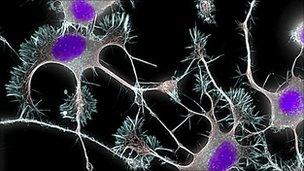Brain works more like internet than 'top down' company
- Published

The brain appears to be a vastly interconnected network much like the Internet, according to new research.
That runs counter to the 19th-Century "top-down" view of brain structure.
A novel technique to track signals across tiny brain regions has revealed connections between regions associated with stress, depression and appetite.
The research, which has been published in Proceedings of the National Academy of Sciences journal, may lead to a full map of the nervous system.
Larry Swanson and Richard Thompson from the University of Southern California in Los Angeles, US, isolated a small section of a rat's brain in the nucleus accumbens - a brain region long associated with pleasure and reward.
Their technique hinges on the injection of "tracers" at precise points in the brain tissue. These are molecules that do not interfere with the movement of signals across the tissue, but can be illuminated and identified using a microscope.
Loops not lines
What is new is that the researchers injected two tracers at the same point at the same time: one that showed where signals were going, and one that showed where they were coming from. The approach can show up to four levels of connection.
If the brain has a hierarchichal structure like a large company, as neurology has long held, the "to" and "from" diagram would show straight lines from independent regions up towards a central processing unit: the company's boss.
But instead, the researchers saw loops between differing regions, feeding back to and directly linking regions that were not known to communicate with one another. This is a better fit with the model of vast networks such as the internet.
The region of the brain studied by the researchers displays a network connecting regions associated with stress, appetite and depression.
Such a highly interconnected structure has been hypothesised for some time, and could prove to be a powerful tool in analysing how the brain processes information. But it had not, until now, been demonstrated experimentally.
"You would be amazed at how much of the current experimental neuroscience literature is dominated by 'top down-bottom up thinking', which goes back to the 19th Century, especially in neurology," Professor Swanson told BBC News.
"The bottom line is that no matter what you might think, the circuitry we've shown - that specific set of structural connections - has not been demonstrated before."
The work illuminates just one tiny corner of the vast number of connections present even in a small mammal's brain. But by slightly overlapping one mapped region with another, and mapping that, a far greater picture could emerge.
"This method is repeatable in a sensible way so that neural networks can be followed as far as they go - ultimately to the whole wiring diagram of the brain," Professor Swanson said.
Such a diagram would be boundlessly complex, and the degree to which it could shed light on the more slippery questions of consciousness and cognition is still up for debate.
"We have no idea right now, but the direct analogy is with the Human Genome Project: taking on faith that knowing the complete sequence of human DNA would be a foundation stone for biology, no matter how long the understanding may take to realise in practical terms."
- Published28 July 2003